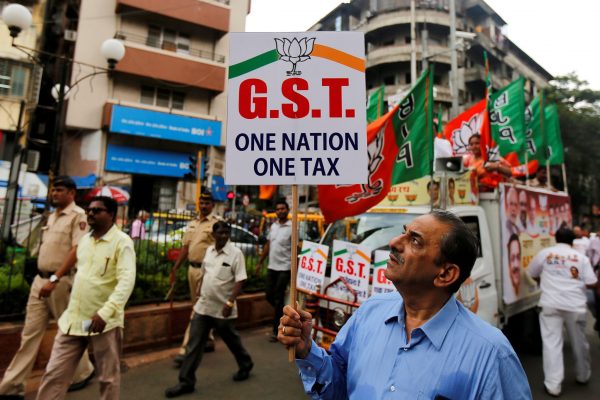The reason for the difference was not cows on the roads, potholes or even communist insurgents. It was taxation.
When a truck travelled from Kolkata to Mumbai, it faced multiple long queues upon passing every state border, waiting to pay the entry tax imposed on the value of the goods on board by each state and waiting again to have it reimbursed upon leaving. On passing through numerous cities, the truck would also have to pay another form of entry tax — the octroi.
In its destination state of Maharashtra, the truck would have been stopped and inspected 12 times before it reached Mumbai, averaging 11 kilometres per hour and spending approximately 32 hours waiting in queues.
On 1 July 2017, India introduced a Goods and Services Tax (GST) with the objective of replacing the dense thicket of national, state and local taxes on consumption with a single tax. If it is successful, it may have created what some term a ‘single national market’ in India for the first time.
It took nearly 16 years from conception to implementation to get to the GST regime that was unveiled in July 2017. Discussions about it were first flagged in 2000, during the Bharatiya Janata Party-led National Democratic Alliance government under then prime minister Atal Bihari Vajpayee.
The original deadline of 1 April 2010 for implementation was missed by seven years, mainly because of the failure to get states on board to enact a constitutional amendment. Under India’s federal structure, moving from state taxes to a consolidated GST meant that the national government needed the power to tax the sale of goods — a states’ list item. Such an amendment required (in addition to a special majority in the federal parliament) assent from at least 50 per cent of the states.
The constitutional amendment bill that was recently passed makes some important concessions to the states. In particular, it protects the states for up to five years against revenue loss that may occur due to the new tax regime.
Implementing a GST in India — a country with millions of very poor citizens and a legacy of multiple consumption taxes — has produced a tax of great complexity. Goods and services are taxed in various ways, ranging from a tax of 5 per cent on snack foods to 48 per cent on large cars. This is in stark contrast to the GST in New Zealand and Australia, which taxes all goods and services at a single rate, with a few exceptions.
The implementation of the GST will be governed by the GST Council, which has the power to change or revise the tax rates applicable to different goods and to create exclusions. The Council has met once since the roll out and has already revised rates on certain commodities.
Three major items of consumption are currently outside the GST’s scope — petroleum products, alcohol and real estate. Taxes on petroleum raise about one third of Indian states’ revenues, while those on alcohol bring in another 25 per cent. The states are unwilling to give up such significant income sources to the national government.
For the hundreds of thousands of small shop owners in India who have kept traditional hand-written ledgers in their mother tongue, the new GST is something of a nightmare. They are now required to file their GST reports online, so in addition to suddenly having to become computer-literate, they face the challenge of navigating the tax portal in English. The burden on service providers who operate in multiple states is also greatly increased by the new GST, since they have to file separate reports for each state.
And in a society where tax-avoidance is something of a national sport, there are reports of small traders finding ways to dodge the new tax. For example, if a pair of shoes costs less than Rs 500 (US$8), they are taxed at 5 per cent, while more expensive shoes are taxed at 18 per cent. Some stores are selling shoes individually to bring the cost below Rs 500.
To bring a reform as complex as the GST into being within Indian federalism, the government had to overcome formidable obstacles. Difficulties and anomalies have inevitably exposed it to criticism.
Yet the government of Prime Minister Narendra Modi and Finance Minister Arun Jaitley deserves full credit for finally securing passage of the GST legislation. Creating a supervisory GST Council to oversee elements such as the adjustments to rates and the mechanics of filing returns is a wise move.
Abolishing border taxes and octroi in many Indian states has emptied many toll booths and freed up the movement of goods and services by road across much of India. The realignment of the ‘economic geography’ of India — a shift in the production and storage centres around the country — will take place as a result. In years to come this will be an area of interest for policymakers and scholars, as this is where major efficiency gains are likely to arise.
Mandar Oak is Associate Professor in Economics at the University of Adelaide.
Peter Mayer is Associate Professor and Visiting Research Fellow in Politics and International Studies at the University of Adelaide.
This article was first published here on Asian Currents.


I have read about the export services and intermediary services update on GST recently. I have heard that it will adversely affect the BPO services which is a major contributor in the Indian economy. I guess you should also mention if GST was doing any good to BPO services earlier.